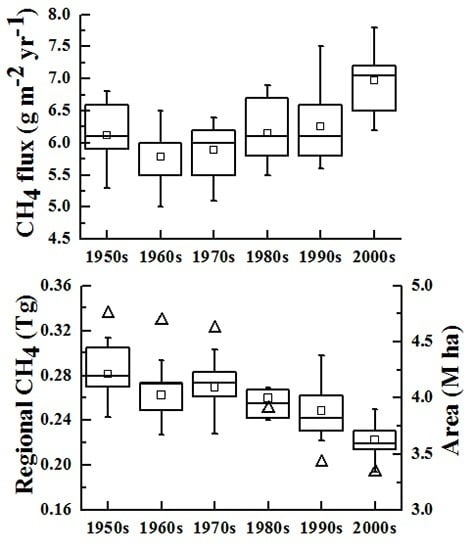Modeling CH4 Emissions from Natural Wetlands on the Tibetan Plateau over the Past 60 Years: Influence of Climate Change and Wetland Loss
Abstract
:1. Introduction
2. Methods and Materials
2.1. Model Framework
2.2. Data Sources
2.3. Model Extrapolation to the TP
3. Results
3.1. Model Validation
3.2. Temporal Variation in CH4 Emissions on the TP
3.3. Spatial Variation in CH4 Emissions from the TP
4. Discussion
4.1. Uncertainties in Model Validation
4.2. Feedback between Climate Change and CH4 Emissions
4.3. Estimates of the Regional CH4 Emissions from the TP
4.4. Uncertainties and Future Needs
4.5. Future Trends in CH4 Emissions from Natural Wetlands on TP
5. Conclusions
Acknowledgments
Author Contributions
Conflicts of Interest
References
- Ramsar Convention Secretariat. Ramsar Handbook for the Wise Use of Wetlands, 2nd ed.; Ramsar Secretariat: Gland, Switzerland, 2004. [Google Scholar]
- Mitsch, W.J.; Gosselink, J.G. Wetlands; John Wiley & Sons: Hoboken, NJ, USA, 2007. [Google Scholar]
- Gardner, R.C.; Davidson, N.C. The ramsar convention. In Wetlands; Springer: Berlin, Germany, 2011; pp. 189–203. [Google Scholar]
- Adams, J.M.; Faure, H.; Faure-Denard, L.; McGlade, J.; Woodward, F. Increases in terrestrial carbon storage from the last glacial maximum to the present. Nature 1990, 348, 711–714. [Google Scholar] [CrossRef]
- Gorham, E. Northern peatlands: Role in the carbon cycle and probable responses to climatic warming. Ecol. Appl. 1991, 1, 182–195. [Google Scholar] [CrossRef]
- Mitra, S.; Wassmann, R.; Vlek, P.L. An appraisal of global wetland area and its organic carbon stock. Curr. Sci. 2005, 88, 25. [Google Scholar]
- Wuebbles, D.J.; Hayhoe, K. Atmospheric methane and global change. Earth Sci. Rev. 2002, 57, 177–210. [Google Scholar] [CrossRef]
- Kapoor, D. Sources and Sinks of Methane: Future Concentrations and Impact on Global Warming. Master’s Thesis, University of Pittsburgh, Pittsburgh, PA, USA, 2006. [Google Scholar]
- IPCC. Climate Change 2013: The Physical Science Basis. Contribution of Working Group i to the Fifth Assessment Report of the Intergovernmental Panel on Climate Change; Cambridge University Press: Cambridge, UK, 2013. [Google Scholar]
- Nisbet, E.G.; Dlugokencky, E.J.; Bousquet, P. Methane on the rise—Again. Science 2014, 343, 493–495. [Google Scholar] [CrossRef] [PubMed]
- Dlugokencky, E.J.; Nisbet, E.G.; Fisher, R.; Lowry, D. Global atmospheric methane: Budget, changes and dangers. Philo. Trans. R. Soc. A 2011, 369, 2058–2072. [Google Scholar] [CrossRef] [PubMed]
- Montzka, S.A.; Dlugokencky, E.J.; Butler, J.H. Non-CO2 greenhouse gases and climate change. Nature 2011, 476, 43–50. [Google Scholar] [CrossRef] [PubMed]
- Fung, I.; John, J.; Lerner, J.; Matthews, E.; Prather, M.; Steele, L.; Fraser, P. Three-dimensional model synthesis of the global methane cycle. J. Geophys. Res. 1991, 96, 13033–13065. [Google Scholar] [CrossRef]
- Hein, R.; Crutzen, P.J.; Heimann, M. An inverse modeling approach to investigate the global atmospheric methane cycle. Glob. Biogeochem. Cycles 1997, 11, 43–76. [Google Scholar] [CrossRef]
- Niu, Z.; Zhang, H.; Wang, X.; Yao, W.; Zhou, D.; Zhao, K.; Zhao, H.; Li, N.; Huang, H.; Li, C. Mapping wetland changes in China between 1978 and 2008. Chin. Sci. Bull. 2012, 57, 2813–2823. [Google Scholar] [CrossRef]
- Chen, H.; Zhu, Q.A.; Peng, C.; Wu, N.; Wang, Y.; Fang, X.; Jiang, H.; Xiang, W.; Chang, J.; Deng, X. Methane emissions from rice paddies natural wetlands, lakes in China: Synthesis new estimate. Glob. Chang. Biol. 2013, 19, 19–32. [Google Scholar] [CrossRef] [PubMed]
- Wei, D.; Tarchen, T.; Dai, D.; Wang, Y.; Wang, Y. Revisiting the role of CH4 emissions from alpine wetlands on the Tibetan Plateau: Evidence from two in situ measurements at 4758 and 4320 m above sea level. J. Geophys. Res. Biogeosci. 2015, 120, 1741–1750. [Google Scholar] [CrossRef]
- Jin, H.; Wu, J.; Cheng, G.; Nakano, T.; Sun, G. Methane emissions from wetlands on the Qinghai-Tibet Plateau. Chin. Sci. Bull. 1999, 44, 2282–2286. [Google Scholar] [CrossRef]
- Ding, W.; Cai, Z.; Wang, D. Preliminary budget of methane emissions from natural wetlands in China. Atmos. Environ. 2004, 38, 751–759. [Google Scholar] [CrossRef]
- Ding, W.X.; Cai, Z.C. Methane emission from natural wetlands in China: Summary of years 1995–2004 studies. Pedosphere 2007, 17, 475–486. [Google Scholar] [CrossRef]
- Chen, H.; Yao, S.; Wu, N.; Wang, Y.; Luo, P.; Tian, J.; Gao, Y.; Sun, G. Determinants influencing seasonal variations of methane emissions from alpine wetlands in Zoige Plateau and their implications. J. Geophys. Res. Atmos. 2008, 113, D12303. [Google Scholar] [CrossRef]
- Cao, M.; Woodward, F. Net primary and ecosystem production and carbon stocks of terrestrial ecosystems and their responses to climate change. Glob. Chang. Biol. 1998, 4, 185–198. [Google Scholar] [CrossRef]
- MacDonald, J.A.; Fowler, D.; Hargreaves, K.J.; Skiba, U.; Leith, I.D.; Murray, M.B. Methane emission rates from a northern wetland; response to temperature, water table and transport. Atmos. Environ. 1998, 32, 3219–3227. [Google Scholar]
- Ding, W.; Cai, Z.; Tsuruta, H.; Li, X. Effect of standing water depth on methane emissions from freshwater marshes in northeast China. Atmos. Environ. 2002, 36, 5149–5157. [Google Scholar] [CrossRef]
- Ballantyne, D.M.; Hribljan, J.A.; Pypker, T.G.; Chimner, R.A. Long-term water table manipulations alter peatland gaseous carbon fluxes in Northern Michigan. Wetl. Ecol. Manag. 2014, 22, 35–47. [Google Scholar] [CrossRef]
- Jorgenson, M.T.; Racine, C.H.; Walters, J.C.; Osterkamp, T.E. Permafrost degradation and ecological changes associated with a warming climate in central Alaska. Clim. Chang. 2001, 48, 551–579. [Google Scholar] [CrossRef]
- Wang, S.L.; Zhao, L.; LI, S.X.; Ji, G.L.; Xie, Y.Q.; Guo, D.X. Study on thermal balance of asphalt pavement and roadbed stability in permafrost regions of the Qinghai-Tibetan highway. J. Glaciol. Geocryol. 2001, 2, 111–118. (In Chinese) [Google Scholar]
- McGuire, A.; Sturm, M.; Chapin, F. Arctic transitions in the land-atmosphere system (ATLAS): Background, objectives, results, and future directions. J. Geophys. Res. Atmos. 2003. [Google Scholar] [CrossRef]
- Li, T.; Huang, Y.; Zhang, W.; Song, C. Ch4mod wetland: A biogeophysical model for simulating methane emissions from natural wetlands. Ecol. Model. 2010, 221, 666–680. [Google Scholar] [CrossRef]
- Huang, Y.; Sass, R.L.; Fisher, F.M., Jr. A semi-empirical model of methane emission from flooded rice paddy soils. Glob. Chang. Biol. 1998, 4, 247–268. [Google Scholar] [CrossRef]
- Huang, Y.; Zhang, W.; Zheng, X.; Li, J.; Yu, Y. Modeling methane emission from rice paddies with various agricultural practices. J. Geophys. Res. Atmos. 2004. [Google Scholar] [CrossRef]
- Li, T.; Huang, Y.; Zhang, W.; Yu, Y.-Q. Methane emissions associated with the conversion of marshland to cropland and climate change on the Sanjiang Plain of northeast China from 1950 to 2100. Biogeosciences 2012. [Google Scholar] [CrossRef]
- Ma, X.H.; Lu, X.G.; Yang, Q.; Yan, M.H. Carbon cycle of a marsh in Sanjiang Plain. Sci. Geogr. Sin. 1996, 16, 323–330. (In Chinese) [Google Scholar] [CrossRef]
- Tian, Y.B.; Xiong, M.B.; Xiong, X.S.; Song, G.Y. The organic carbon distribution and flow in wetland soil-plant system in Ruoergai Plateau. Acta Phytoecol. Sin. 2003, 27, 490–495. (In Chinese) [Google Scholar]
- Hirota, M.; Tang, Y.; Hu, Q.; Hirata, S.; Kato, T.; Mo, W.; Cao, G.; Mariko, S. Methane emissions from different vegetation zones in a Qinghai-Tibetan Plateau wetland. Soil Biol. Biochem. 2004, 36, 737–748. [Google Scholar] [CrossRef]
- State Soil Survey Service of China. China Soil Series, 6th ed.; China Agriculture Press: Beijing, China, 1994; pp. 518–519. (In Chinese) [Google Scholar]
- State Soil Survey Service of China. China Soil Series, 5th ed.; China Agriculture Press: Beijing, China, 1995; pp. 668–669. (In Chinese) [Google Scholar]
- Zhuang, Q.; Melillo, J.M.; Kicklighter, D.W.; Prinn, R.G.; McGuire, A.D.; Steudler, P.A.; Felzer, B.S.; Hu, S. Methane fluxes between terrestrial ecosystems and the atmosphere at northern high latitudes during the past century: A retrospective analysis with a process-based biogeochemistry model. Glob. Biogeochem. Cycles 2004. [Google Scholar] [CrossRef]
- Zhuang, Q.; He, J.; Lu, Y.; Ji, L.; Xiao, J.; Luo, T. Carbon dynamics of terrestrial ecosystems on the Tibetan Plateau during the 20th century: An analysis with a process-based biogeochemical model. Glob. Ecol. Biogeogr. 2010, 19, 649–662. [Google Scholar] [CrossRef]
- McGuire, A.D.; Melillo, J.; Joyce, L.; Kicklighter, D.; Grace, A.; Moore, B.; Vorosmarty, C. Interactions between carbon and nitrogen dynamics in estimating net primary productivity for potential vegetation in north america. Glob. Biogeochem. Cycles 1992, 6, 101–124. [Google Scholar] [CrossRef]
- Melillo, J.M.; McGuire, A.D.; Kicklighter, D.W.; Moore, B.; Vorosmarty, C.J.; Schloss, A.L. Global climate change and terrestrial net primary production. Nature 1993, 363, 234–240. [Google Scholar] [CrossRef]
- Cramer, W.; Kicklighter, D.; Bondeau, A.; Iii, B.M.; Churkina, G.; Nemry, B.; Ruimy, A.; Schloss, A.L. The participants of the potsdam NPP Model Intercomparison. Comparing global models of terrestrial net primary productivity (NPP): Overview and key results. Glob. Chang. Biol. 1999, 5, 1–15. [Google Scholar] [CrossRef]
- Letts, M.G.; Roulet, N.T.; Comer, N.T.; Skarupa, M.R.; Verseghy, D.L. Parametrization of peatland hydraulic properties for the canadian land surface scheme. Atmos. Ocean 2000, 38, 141–160. [Google Scholar] [CrossRef]
- Bohn, T.; Lettenmaier, D.; Sathulur, K.; Bowling, L.; Podest, E.; McDonald, K.; Friborg, T. Methane emissions from western Siberian wetlands: Heterogeneity and sensitivity to climate change. Environ. Res. Lett. 2007, 2, 045015. [Google Scholar] [CrossRef]
- Kleinen, T.; Brovkin, V.; Schuldt, R. A dynamic model of wetland extent and peat accumulation: Results for the holocene. Biogeosciences 2012, 9, 235–248. [Google Scholar] [CrossRef] [Green Version]
- Lu, X.; Zhuang, Q. Modeling methane emissions from the Alaskan Yukon river basin, 1986–2005, by coupling a large-scale hydrological model and a process-based methane model. J. Geophys. Res. Biogeosci. 2012, 117, G02010. [Google Scholar] [CrossRef]
- Zhu, X.; Zhuang, Q.; Gao, X.; Sokolov, A.; Schlosser, C.A. Pan-arctic land–atmospheric fluxes of methane and carbon dioxide in response to climate change over the 21st century. Environ. Res. Lett. 2013. [Google Scholar] [CrossRef]
- Wang, Y.; Wang, Y. Quick measurement of CH4, CO2 and N2O emissions from a short-plant ecosystem. Adv. Atmos. Sci. 2003, 20, 842–844. [Google Scholar]
- Wang, D.; Lv, X.; Ding, W.; Cai, Z.; Gao, J.; Yang, F. Methan emission from narshes in Zoige Plateau. Adv. Earth Sci. 2002, 17, 877–880. (In Chinese) [Google Scholar]
- Harris, I.; Jones, P.; Osborn, T.; Lister, D. Updated high-resolution grids of monthly climatic observations—The CRU TS3.10 Dataset. Int. J. Climatol. 2014, 34, 623–642. [Google Scholar] [CrossRef] [Green Version]
- FAO/IIASA/ISRIC/ISS-CAS/JRC. Harmonized World Soil Database, 1.2nd ed.; FAO and IIASA: Rome, Italy, 2012. [Google Scholar]
- Belward, A.S.; Estes, J.E.; Kline, K.D. The IGBP-DIS global 1-km land-cover data set discover: A project overview. Photogramm. Eng. Remote Sens. 1999, 65, 1013–1020. [Google Scholar]
- Loveland, T.; Reed, B.; Brown, J.; Ohlen, D.; Zhu, Z.; Yang, L.; Merchant, J. Development of a global land cover characteristics database and igbp discover from 1 km avhrr data. Int. J. Remote Sens. 2000, 21, 1303–1330. [Google Scholar] [CrossRef]
- Fan, Y.; van den Dool, H. Climate prediction center global monthly soil moisture data set at 0.5 resolution for 1948 to present. J. Geophys. Res. Atmos. 2004. [Google Scholar] [CrossRef]
- USGS. US Geological Survey: HYDRO1k Elevation Derivative Database; US Geological Survey Earth Resources Observation and Science (EROS) Center: Sioux Falls, SD, USA, 2000.
- FAO/IIASA/ISRIC/ISS-CAS/JRC. Harmonized World Soil Database, 1st ed.; FAO and IIASA: Rome, Italy, 2008. [Google Scholar]
- National Research Council (NRC). Wetlands: Characteristics and Boundaries; National Academy Press: Washington, DC, USA, 1995.
- An, S.; Li, H.; Guan, B.; Zhou, C.; Wang, Z.; Deng, Z.; Zhi, Y.; Liu, Y.; Xu, C.; Fang, S. China’s natural wetlands: Past problems, current status, and future challenges. AMBIO 2007, 36, 335–342. [Google Scholar] [CrossRef]
- Sargent, R.G. Verification and validation of simulation models. In Proceedings of the 37th Conference on Winter Simulation, Syracuse University, Syracuse, NY, USA, 8–11 December 2002.
- Jin, Z.; Zhuang, Q.; He, J.S.; Zhu, X.; Song, W. Net exchanges of methane and carbon dioxide on the Qinghai-Tibetan Plateau from 1979 to 2100. Environ. Res. Lett. 2015. [Google Scholar] [CrossRef]
- Boon, P.I.; Mitchell, A.; Lee, K. Effects of wetting and drying on methane emissions from ephemeral floodplain wetlands in South-Eastern Australia. Hydrobiologia 1997, 357, 73–87. [Google Scholar] [CrossRef]
- Xu, X.; Tian, H. Methane exchange between marshland and the atmosphere over China during 1949–2008. Glob. Biogeochem. Cycles 2012. [Google Scholar] [CrossRef]
- Zhu, X.; Zhuang, Q.; Chen, M.; Sirin, A.; Melillo, J.; Kicklighter, D.; Sokolov, A.; Song, L. Rising methane emissions in response to climate change in Northern Eurasia during the 21st century. Environ. Res. Lett. 2011. [Google Scholar] [CrossRef]
- Todd-Brown, K.; Randerson, J.; Post, W.; Hoffman, F.; Tarnocai, C.; Schuur, E.; Allison, S. Causes of variation in soil carbon simulations from CMIP5 earth system models and comparison with observations. Biogeosciences 2013. [Google Scholar] [CrossRef]
- Wieder, W.R.; Cleveland, C.C.; Smith, W.K.; Todd-Brown, K. Future productivity and carbon storage limited by terrestrial nutrient availability. Nat. Geosci. 2015, 8, 441–444. [Google Scholar] [CrossRef]
- Whiting, G.J.; Chanton, J.P. Primary productiong control of methane emission from wetlands. Nature 1993, 364, 794–795. [Google Scholar] [CrossRef]
- King, J.Y.; Reeburgh, W.S. A pulse-labeling experiment to determine the contribution of recent plant photosynthates to net methane emission in arctic wet sedge tundra. Soil Biol. Biochem. 2002, 34, 173–180. [Google Scholar] [CrossRef]
- Euliss, N.H.; Gleason, R.; Olness, A.; McDougal, R.; Murkin, H.; Robarts, R.; Bourbonniere, R.; Warner, B. North American prairie wetlands are important nonforested land-based carbon storage sites. Sci. Total Environ. 2006, 361, 179–188. [Google Scholar] [CrossRef] [PubMed]
- Lal, R.; Griffin, M.; Apt, J.; Lave, L.; Morgan, M.G. Managing soil carbon. Science 2004, 304, 393. [Google Scholar] [CrossRef] [PubMed]
- Maltby, E.; Immirzi, P. Carbon dynamics in peatlands and other wetland soils regional and global perspectives. Chemosphere 1993, 27, 999–1023. [Google Scholar] [CrossRef]
- Huang, Y.; Sun, W.; Zhang, W.; Yu, Y.; Su, Y.; Song, C. Marshland conversion to cropland in northeast China from 1950 to 2000 reduced the greenhouse effect. Glob. Chang. Biol. 2010, 16, 680–695. [Google Scholar] [CrossRef]
- Huttunen, J.T.; Nykänen, H.; Martikainen, P.J.; Nieminen, M. Fluxes of nitrous oxide and methane from drained peatlands following forest clear-felling in Southern Finland. Plant. Soil 2003, 255, 457–462. [Google Scholar] [CrossRef]
- Freeman, C.; Lock, M.A.; Reynolds, B. Fluxes of CO2, CH4 and N2O from a welsh peatland following simulation of water table draw-down: Potential feedback to climatic change. Biogeochemistry 1992, 19, 51–60. [Google Scholar] [CrossRef]
- Zhang, X.; Jiang, H. Spatial variations in methane emissions from natural wetlands in China. Int. J. Environ. Sci. Technol. 2014, 11, 77–86. [Google Scholar] [CrossRef]
- Wang, D. Emission fluxes of carbon dioxide, methane and nitrous oxide from peat marsh in Zoige Plateau. Wetl. Sci. 2010, 8, 220–224. (In Chinese) [Google Scholar]
- Papa, F.; Prigent, C.; Aires, F.; Jimenez, C.; Rossow, W.; Matthews, E. Interannual variability of surface water extent at the global scale, 1993–2004. J. Geophys. Res. Atmos. 2010, 115, D12111. [Google Scholar] [CrossRef]
- Liu, L.; Greaver, T.L. A review of nitrogen enrichment effects on three biogenic GHGs: The CO2 sink may be largely offset by stimulated N2O and CH4 emission. Ecol. Lett. 2009, 12, 1103–1117. [Google Scholar] [CrossRef] [PubMed]
- Gomez-Casanovas, N.; Hudiburg, T.W.; Bernacchi, C.J.; Parton, W.J.; DeLucia, E.H. Nitrogen deposition and greenhouse gas emissions from grasslands: Uncertainties and future directions. Glob. Chang. Biol. 2016, 22, 1348–1360. [Google Scholar] [CrossRef] [PubMed]
- LeBauer, D.S.; Treseder, K.K. Nitrogen limitation of net primary productivity in terrestrial ecosystems is globally distributed. Ecology 2008, 89, 371–379. [Google Scholar] [CrossRef] [PubMed]
- Berg, B.; Laskowski, R. Litter decomposition: A guide to carbon and nutrient turnover. Adv. Ecol. Res. 2004, 38, 1–421. [Google Scholar]
- Le Mer, J.; Roger, P. Production, oxidation, emission and consumption of methane by soils: A review. Eur. J. Soil Biol. 2001, 37, 25–50. [Google Scholar] [CrossRef]
- Bodelier, P.L.; Laanbroek, H.J. Nitrogen as a regulatory factor of methane oxidation in soils and sediments. FEMS Microbiol. Ecol. 2004, 47, 265–277. [Google Scholar] [CrossRef]
- Liu, X.; Zhang, Y.; Han, W.; Tang, A.; Shen, J.; Cui, Z.; Vitousek, P.; Erisman, J.W.; Goulding, K.; Christie, P.; et al. Enhanced nitrogen deposition over China. Nature 2013, 494, 459–462. [Google Scholar] [CrossRef] [PubMed]
- Prigent, C.; Papa, F.; Aires, F.; Rossow, W.; Matthews, E. Global inundation dynamics inferred from multiple satellite observations, 1993–2000. J. Geophys. Res. Atmos. 2007, 112, D12107. [Google Scholar] [CrossRef]
- Schroeder, R.; Rawlins, M.A.; McDonald, K.C.; Podest, E.; Zimmermann, R.; Kueppers, M. Satellite microwave remote sensing of north Eurasian inundation dynamics: Development of coarse-resolution products and comparison with high-resolution synthetic aperture radar data. Environ. Res. Lett. 2010. [Google Scholar] [CrossRef]
- Lehner, B.; Döll, P. Development and validation of a global database of lakes, reservoirs and wetlands. J. Hydrol. 2004, 296, 1–22. [Google Scholar] [CrossRef]
- Bergamaschi, P.; Frankenberg, C.; Meirink, J.; Krol, M.; Dentener, F.; Wagner, T.; Platt, U.; Kaplan, J.; Körner, S.; Heimann, M. Satellite chartography of atmospheric methane from sciamachy on board Envisat: 2. Evaluation based on inverse model simulations. J. Geophys. Res. Atmos. 2007, 112, D2. [Google Scholar] [CrossRef]
- Melton, J.; Wania, R.; Hodson, E.; Poulter, B.; Ringeval, B.; Spahni, R.; Bohn, T.; Avis, C.; Beerling, D.; Chen, G. Present state of global wetland extent and wetland methane modelling: Conclusions from a model intercomparison project (WETCHIMP). Biogeosciences 2013, 10, 753–788. [Google Scholar] [CrossRef]
- Zhu, P.; Gong, P. Suitability mapping of global wetland areas and validation with remotely sensed data. Sci. China Earth Sci. 2014, 57, 2283–2292. [Google Scholar] [CrossRef]
- Zhang, Z.; Zimmermann, N.E.; Kaplan, J.O.; Poulter, B. Modeling spatiotemporal dynamics of global wetlands: Comprehensive evaluation of a new sub-grid topmodel parameterization and uncertainties. Biogeosciences 2016, 13, 1387–1408. [Google Scholar] [CrossRef]
- Wania, R.; Melton, J.; Hodson, E.; Poulter, B.; Ringeval, B.; Spahni, R.; Bohn, T.; Avis, C.; Chen, G.; Eliseev, A. Present state of global wetland extent and wetland methane modelling: Methodology of a model inter-comparison project (WETCHIMP). Geosci. Model. Dev. 2013, 6, 617–641. [Google Scholar] [CrossRef]
- IPCC. Climate Change 2014, Impacts, Adaptation, and Vulnerability Summaries, Frequently Asked Questions, and Cross-Chapter Boxes. A Contribution of Working Group ii to the Fifth Assessment Report of the Intergovernmental Panel on Climate Change; World Meteorological Organization: Geneva, Switzerland, 2014. [Google Scholar]
- Moss, R.H.; Edmonds, J.A.; Hibbard, K.A.; Manning, M.R.; Rose, S.K.; Van Vuuren, D.P.; Carter, T.R.; Emori, S.; Kainuma, M.; Kram, T. The next generation of scenarios for climate change research and assessment. Nature 2010, 463, 747–756. [Google Scholar] [CrossRef] [PubMed]
- Ji, Z.; Kang, S. Double-nested dynamical downscaling experiments over the Tibetan plateau and their projection of climate change under two RCP scenarios. J. Atmos. Sci. 2013, 70, 1278–1290. [Google Scholar] [CrossRef]
- Editoral Committee. China Wetlands Encyclopedia; Beijing Science and Technology Press: Beijing, China, 2009. [Google Scholar]
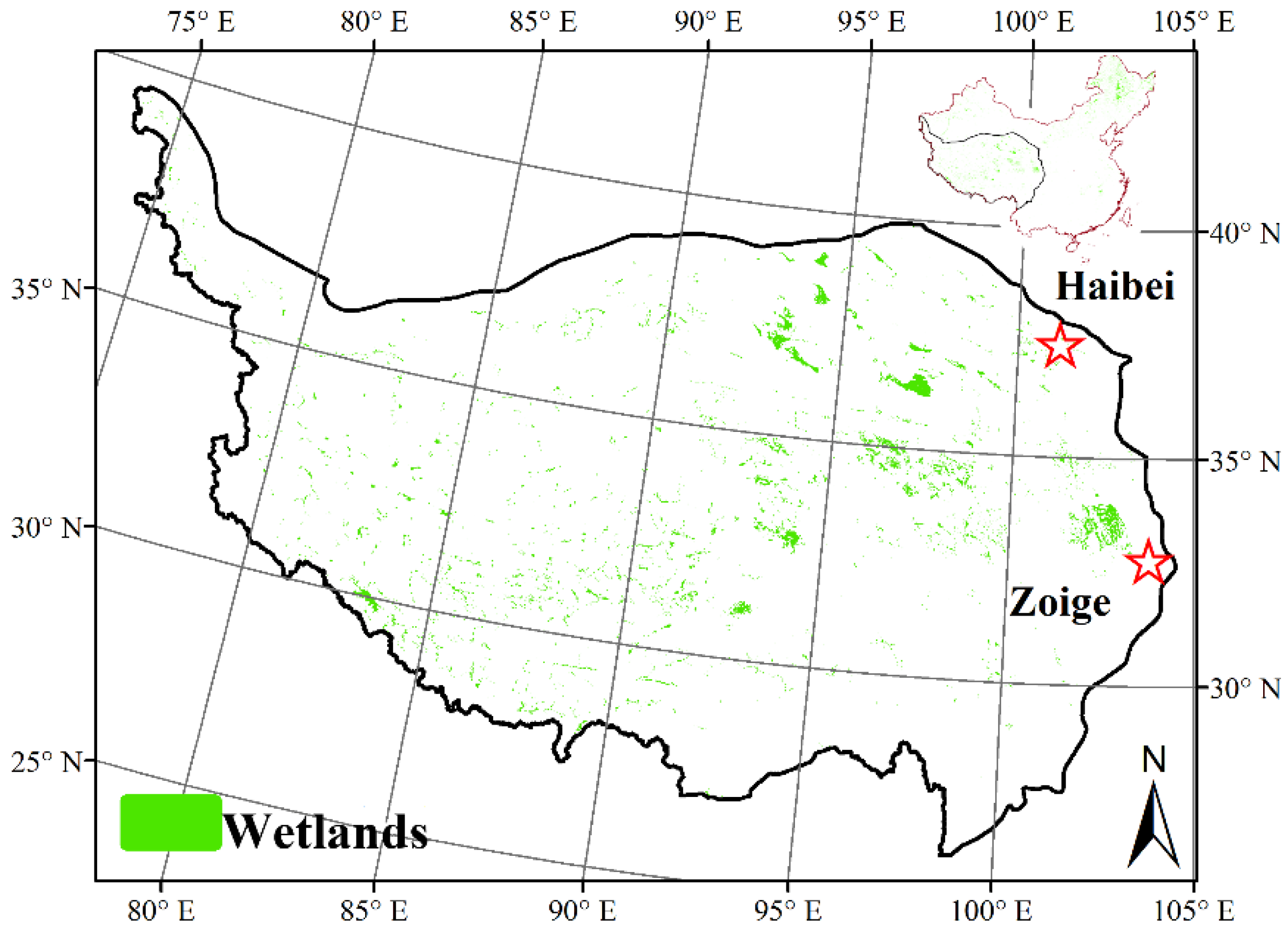
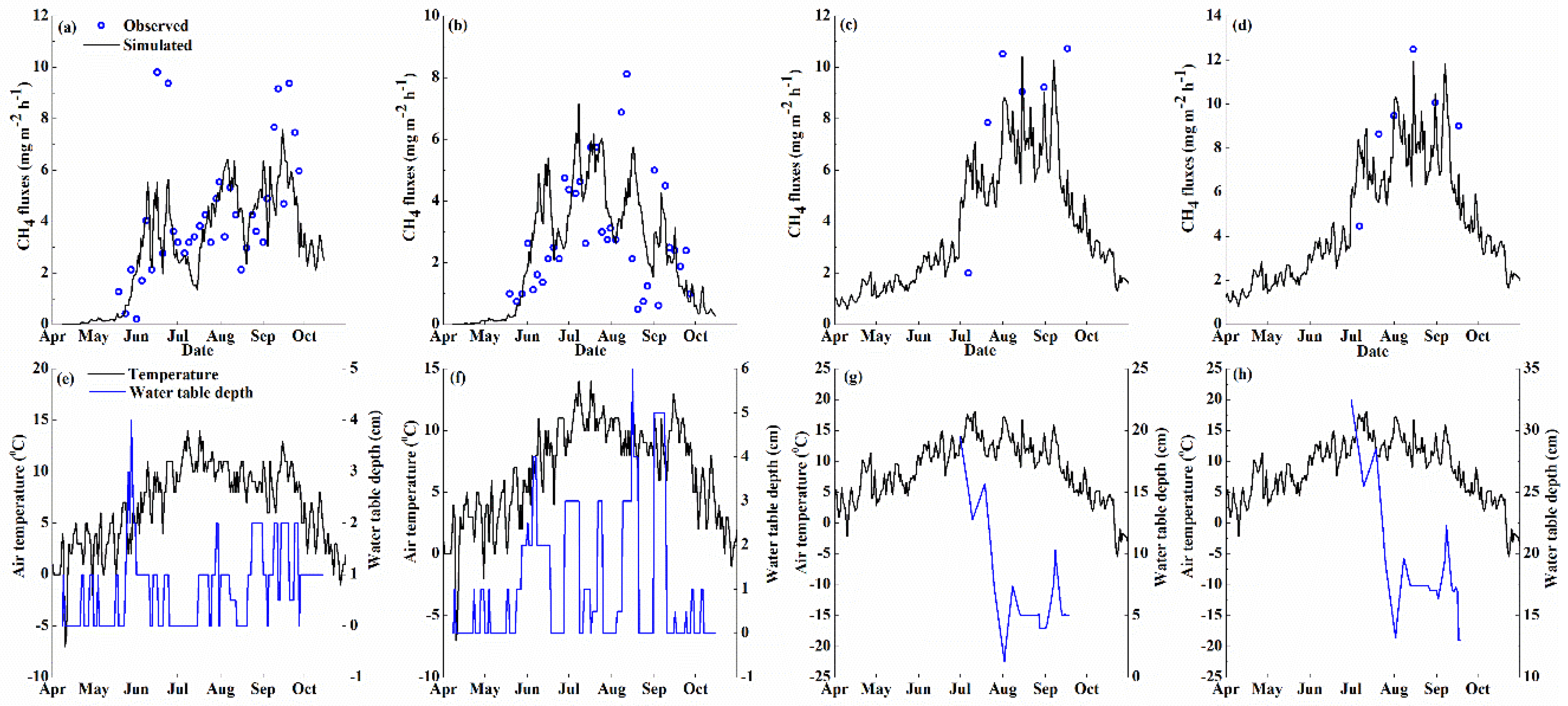
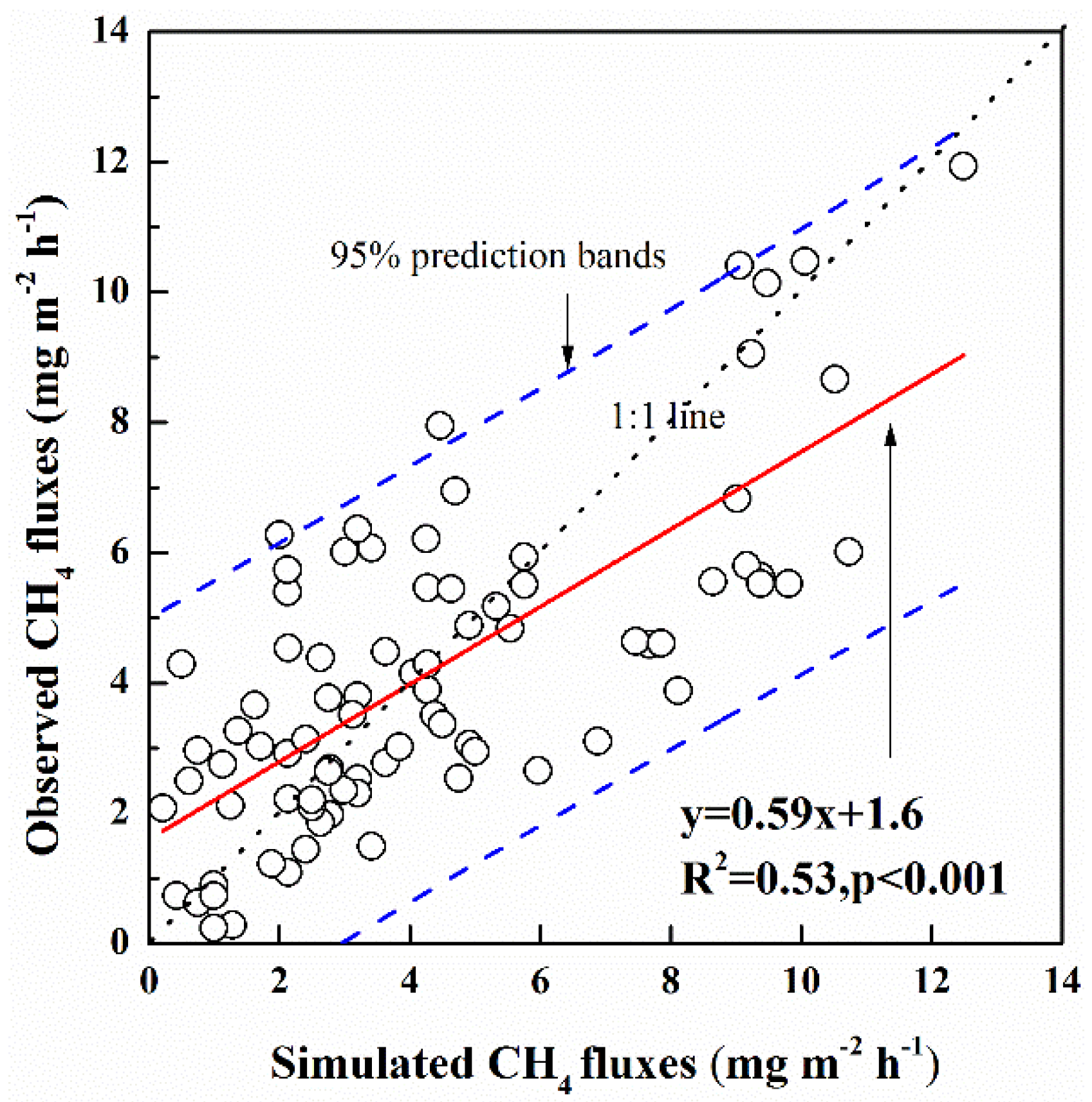
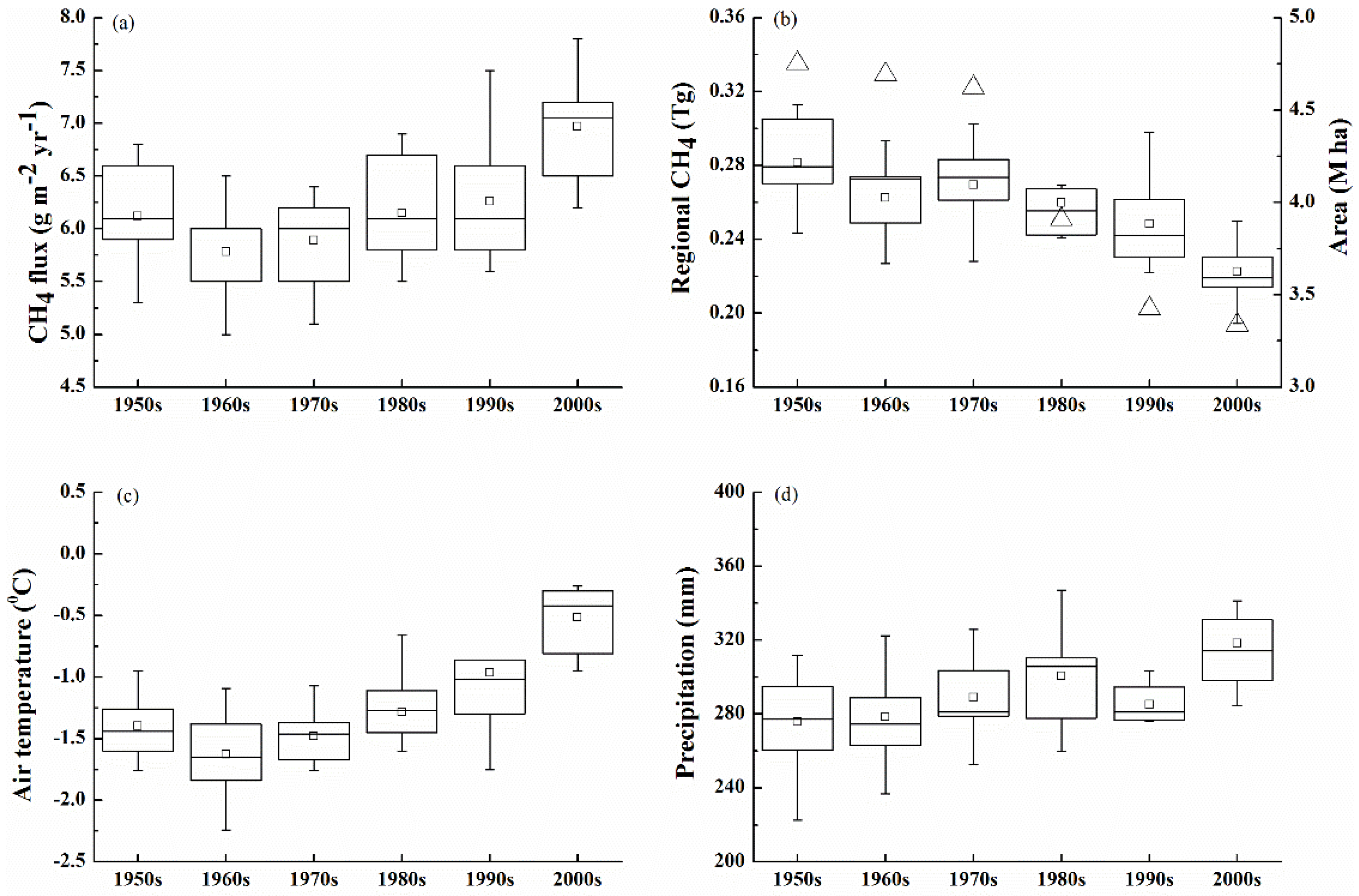
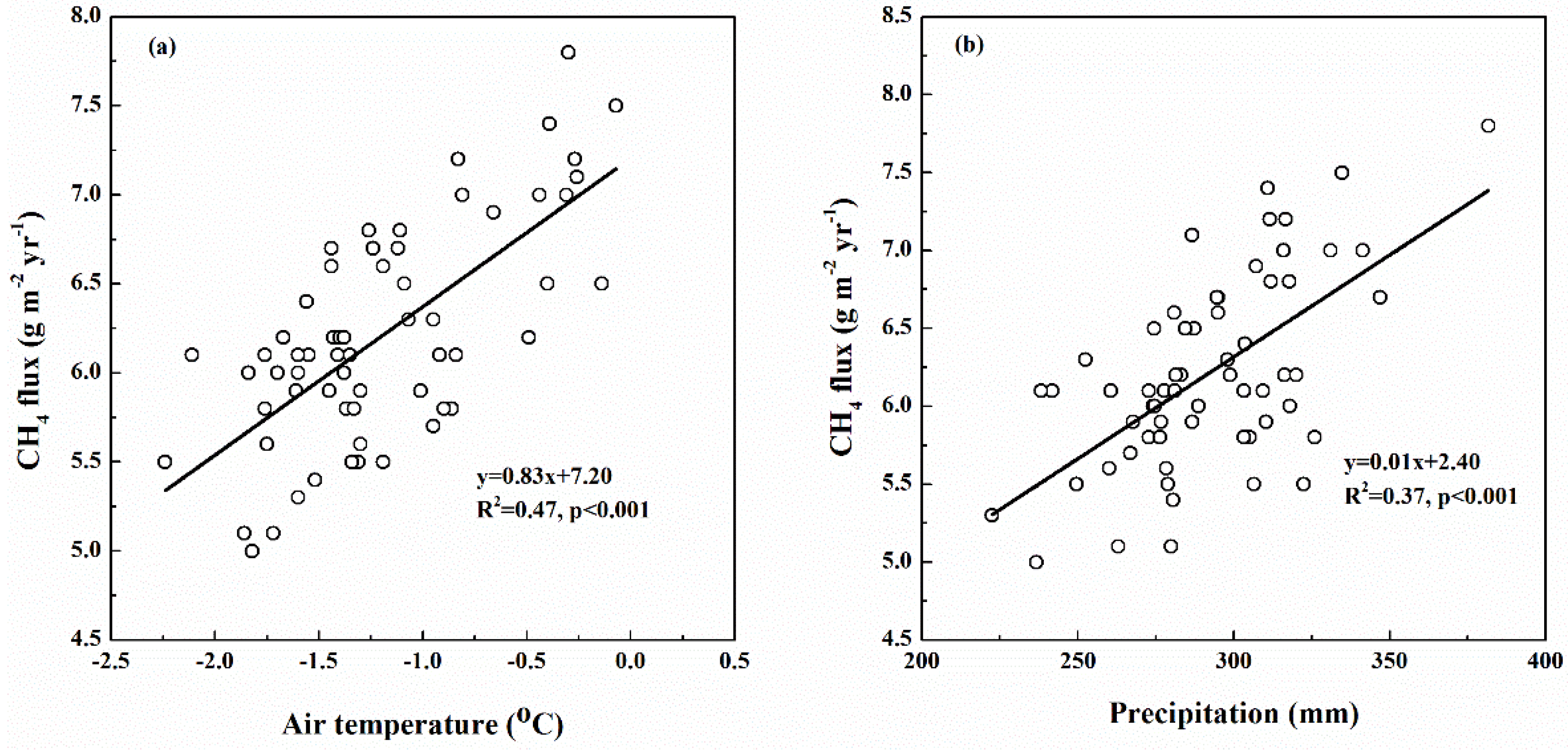
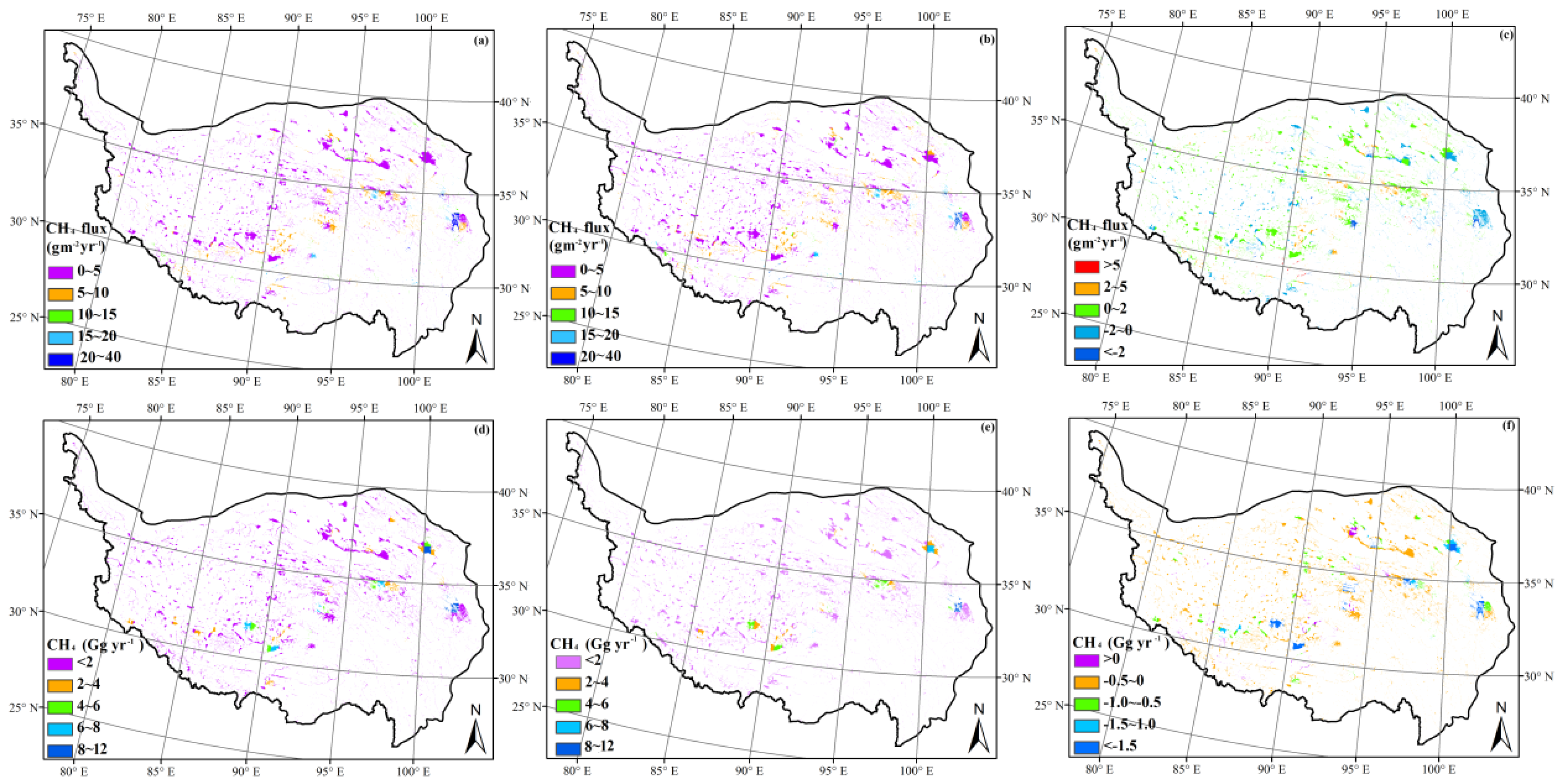
| Parameters/INPUTS (unit) | Description | Values | References | |
|---|---|---|---|---|
| Ruoergai | Haibei | |||
| VI (dimensionless) ^ | Vegetation index | 2.4 | 2.8 | [29] |
| froot (dimensionless) ^ | Proportion of below-ground to the total production | 0.5 | 0.5 | [33] |
| Pox (dimensionless) ^ | The fraction of CH4 oxidized during plant mediated transport | 0.5 | 0.5 | [29] |
| Tveg (dimensionless) ^ | The fraction of plant mediated transport was available | 1 | 1 | [29] |
| ANPP (g m−2 year−1) * | Aboveground net primary productivity | 340 a, 290 b | 380 c, 397 d | [34,35] |
| SAND (%) * | Soil sand fraction | 66.0 | 50 | [36,37] |
| SOM (g kg−1) * | Concentration of soil organic matter | 520 | 16.8 | |
| ρ (g cm−3) * | Soil bulk density | 0.75 | 1.73 | |
| Site | Observed Seasonal CH4 (g m−2 season−1) | Simulated Seasonal CH4 (g m−2 season−1) | RMSE (%) | RMD (%) | EF^ Dimensionless |
|---|---|---|---|---|---|
| Zoige | 11.3 | 12.2 | 53.8 | −2.5 | 0.29 |
| Haibei | 16.0 | 12.6 | 30.6 | −5.4 | 0.05 |
| All | 13.6 | 12.4 | 47.4 | −3.4 | 0.52 |
| Method | Period | Area (M ha) | CH4 (Tg) | Source |
|---|---|---|---|---|
| Site specific extrapolation | 1996–1997 | 18.80 | 0.70–0.90 | [18] |
| Site specific extrapolation | 2001–2002 | 5.52 | 0.56 | [19] |
| Site specific extrapolation | 2000 | Nm # | 1.25 | [16] |
| Site specific extrapolation | 2012–2014 | 6.32 | 0.22–0.41 | [17] |
| Meta-Analysis | 1990–2010 | 3.76 | 1.04 | [74] |
| Model | 2001–2011 | 13.40 | 0.95 | [60] |
| Model | 2008 | 3.20 | 0.06 | [62] |
| Model | 2000–2010 | 3.33 | 0.22 | This study |
© 2016 by the authors; licensee MDPI, Basel, Switzerland. This article is an open access article distributed under the terms and conditions of the Creative Commons Attribution (CC-BY) license (http://creativecommons.org/licenses/by/4.0/).
Share and Cite
Li, T.; Zhang, Q.; Cheng, Z.; Ma, Z.; Liu, J.; Luo, Y.; Xu, J.; Wang, G.; Zhang, W. Modeling CH4 Emissions from Natural Wetlands on the Tibetan Plateau over the Past 60 Years: Influence of Climate Change and Wetland Loss. Atmosphere 2016, 7, 90. https://doi.org/10.3390/atmos7070090
Li T, Zhang Q, Cheng Z, Ma Z, Liu J, Luo Y, Xu J, Wang G, Zhang W. Modeling CH4 Emissions from Natural Wetlands on the Tibetan Plateau over the Past 60 Years: Influence of Climate Change and Wetland Loss. Atmosphere. 2016; 7(7):90. https://doi.org/10.3390/atmos7070090
Chicago/Turabian StyleLi, Tingting, Qing Zhang, Zhigang Cheng, Zhenfeng Ma, Jia Liu, Yu Luo, Jingjing Xu, Guocheng Wang, and Wen Zhang. 2016. "Modeling CH4 Emissions from Natural Wetlands on the Tibetan Plateau over the Past 60 Years: Influence of Climate Change and Wetland Loss" Atmosphere 7, no. 7: 90. https://doi.org/10.3390/atmos7070090
APA StyleLi, T., Zhang, Q., Cheng, Z., Ma, Z., Liu, J., Luo, Y., Xu, J., Wang, G., & Zhang, W. (2016). Modeling CH4 Emissions from Natural Wetlands on the Tibetan Plateau over the Past 60 Years: Influence of Climate Change and Wetland Loss. Atmosphere, 7(7), 90. https://doi.org/10.3390/atmos7070090





